口译lesson 1
- 格式:doc
- 大小:35.50 KB
- 文档页数:6
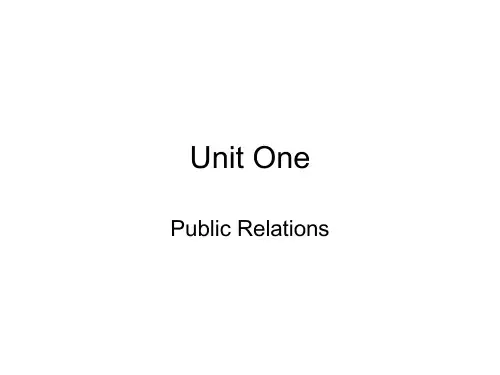
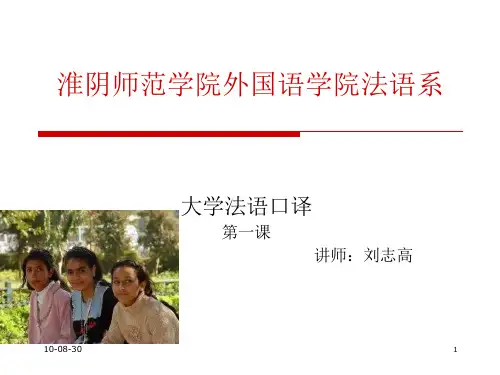
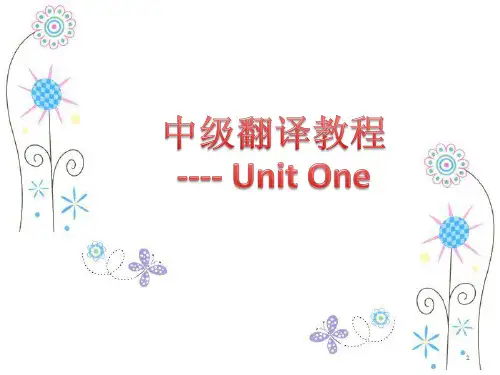
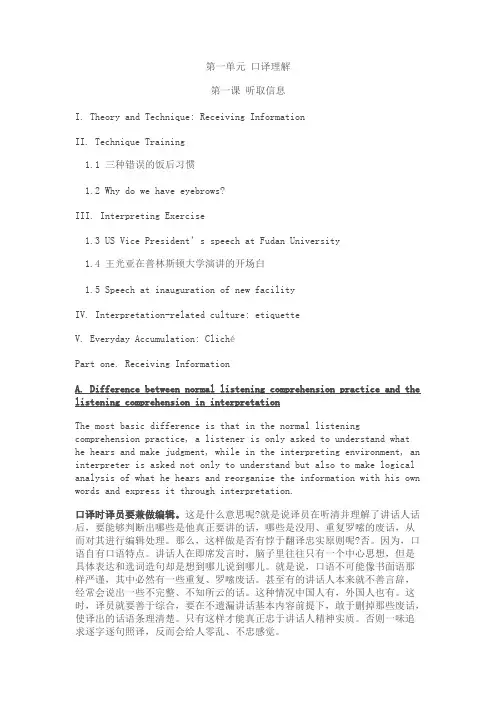
第一单元口译理解第一课听取信息I. Theory and Technique: Receiving InformationII. Technique Training1.1 三种错误的饭后习惯1.2 Why do we have eyebrows?III. Interpreting Exercise1.3 US Vice President’s speech at Fudan University1.4 王光亚在普林斯顿大学演讲的开场白1.5 Speech at inauguration of new facilityIV. Interpretation-related culture: etiquetteV. Everyday Accumulation: ClichéPart one. Receiving InformationA. Difference between normal listening comprehension practice and the listening comprehension in interpretationThe most basic difference is that in the normal listening comprehension practice, a listener is only asked to understand what he hears and make judgment, while in the interpreting environment, an interpreter is asked not only to understand but also to make logical analysis of what he hears and reorganize the information with his own words and express it through interpretation.口译时译员要兼做编辑。

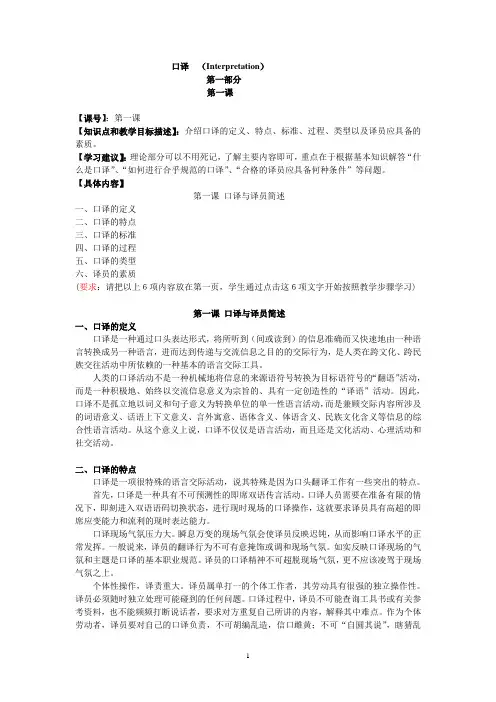
口译(Interpretation)第一部分第一课【课号】:第一课【知识点和教学目标描述】:介绍口译的定义、特点、标准、过程、类型以及译员应具备的素质。
【学习建议】:理论部分可以不用死记,了解主要内容即可,重点在于根据基本知识解答“什么是口译”、“如何进行合乎规范的口译”、“合格的译员应具备何种条件”等问题。
【具体内容】第一课口译与译员简述一、口译的定义二、口译的特点三、口译的标准四、口译的过程五、口译的类型六、译员的素质(要求:请把以上6项内容放在第一页,学生通过点击这6项文字开始按照教学步骤学习)第一课口译与译员简述一、口译的定义口译是一种通过口头表达形式,将所听到(间或读到)的信息准确而又快速地由一种语言转换成另一种语言,进而达到传递与交流信息之目的的交际行为,是人类在跨文化、跨民族交往活动中所依赖的一种基本的语言交际工具。
人类的口译活动不是一种机械地将信息的来源语符号转换为目标语符号的“翻语”活动,而是一种积极地、始终以交流信息意义为宗旨的、具有一定创造性的“译语”活动。
因此,口译不是孤立地以词义和句子意义为转换单位的单一性语言活动,而是兼顾交际内容所涉及的词语意义、话语上下文意义、言外寓意、语体含义、体语含义、民族文化含义等信息的综合性语言活动。
从这个意义上说,口译不仅仅是语言活动,而且还是文化活动、心理活动和社交活动。
二、口译的特点口译是一项很特殊的语言交际活动,说其特殊是因为口头翻译工作有一些突出的特点。
首先,口译是一种具有不可预测性的即席双语传言活动。
口译人员需要在准备有限的情况下,即刻进入双语语码切换状态,进行现时现场的口译操作,这就要求译员具有高超的即席应变能力和流利的现时表达能力。
口译现场气氛压力大。
瞬息万变的现场气氛会使译员反映迟钝,从而影响口译水平的正常发挥。
一般说来,译员的翻译行为不可有意掩饰或调和现场气氛。
如实反映口译现场的气氛和主题是口译的基本职业规范。
译员的口译精神不可超脱现场气氛,更不应该凌驾于现场气氛之上。
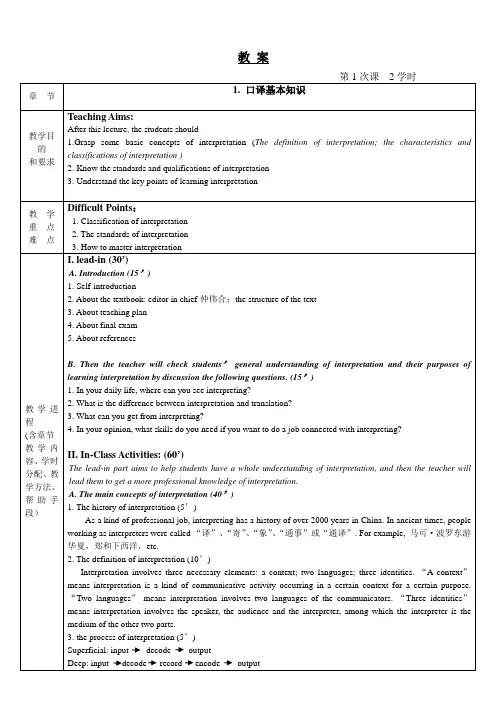
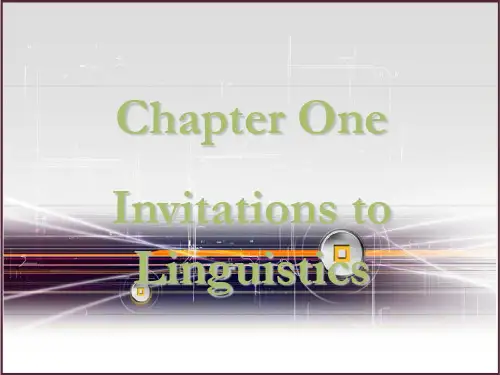
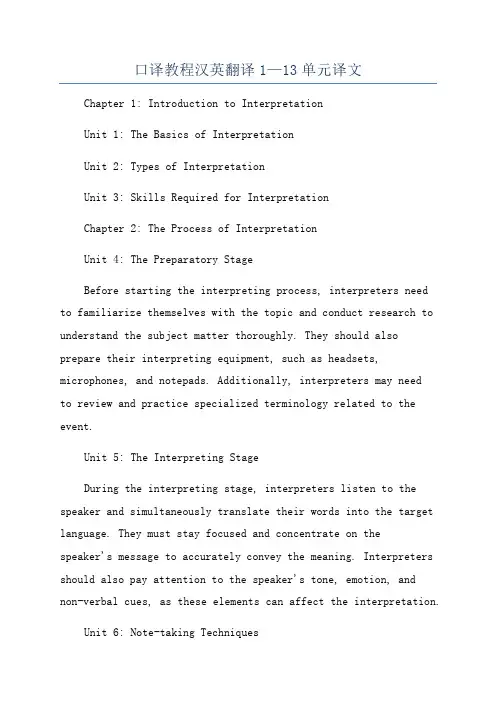
口译教程汉英翻译1—13单元译文Chapter 1: Introduction to InterpretationUnit 1: The Basics of InterpretationUnit 2: Types of InterpretationUnit 3: Skills Required for InterpretationChapter 2: The Process of InterpretationUnit 4: The Preparatory StageBefore starting the interpreting process, interpreters need to familiarize themselves with the topic and conduct research to understand the subject matter thoroughly. They should also prepare their interpreting equipment, such as headsets, microphones, and notepads. Additionally, interpreters may needto review and practice specialized terminology related to the event.Unit 5: The Interpreting StageDuring the interpreting stage, interpreters listen to the speaker and simultaneously translate their words into the target language. They must stay focused and concentrate on thespeaker's message to accurately convey the meaning. Interpreters should also pay attention to the speaker's tone, emotion, and non-verbal cues, as these elements can affect the interpretation.Unit 6: Note-taking TechniquesNote-taking is an essential skill for interpreters.Effective note-taking allows interpreters to retain important information and assist with memory recall during interpretation. Interpreters should develop their own note-taking system and use abbreviations and symbols to jot down key points quickly. However, note-taking should not interfere with active listening and immediate interpretation.Chapter 3: Consecutive InterpretationUnit 7: Introduction to Consecutive InterpretationConsecutive interpretation involves listening to one or several sentences in the source language and then reproducing them in the target language. It requires good memory retention and the ability to accurately convey the meaning. Interpreters should take notes and use their notes as a reference during the interpretation.Unit 8: The Techniques of Consecutive InterpretationInterpreters use several techniques during consecutive interpretation to ensure accurate and fluent delivery. These techniques include paraphrasing, summarizing, clarifying ambiguous statements, and maintaining natural rhythm and pacing. Interpreters should also adapt their interpretation style to match the speaker's tone and style.Unit 9: Consecutive Interpretation PracticeInterpreters can practice consecutive interpretation by engaging in role plays or shadowing experienced interpreters. They can also utilize practice materials, such as speeches, interviews, or articles, to improve their interpretation skills. Regular practice is essential for enhancing memory retention, improving fluency, and perfecting delivery.。
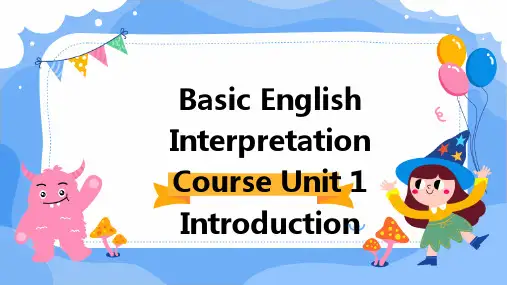
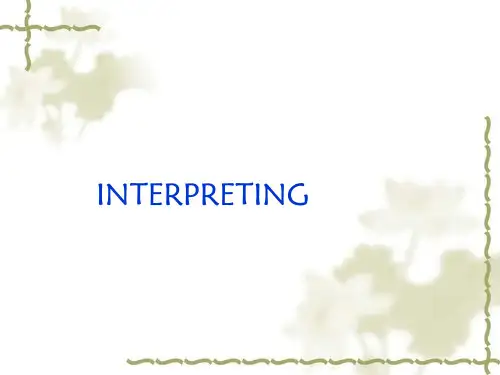
Unit One Foreign Affairs ReceptionLearning Objectives:※A good understanding of the definition of business communication.※A clear idea of the procedures for a foreign affairs reception.※How to be a successful host.Background InformationWith China’s entry into the WTO and the Olympic Games held in Beijing, the relationship between China and Western countries in politics, economy, and culture is getting increasingly closer. There is no doubt that etiquette will play an important role in this process. Every nation has its own etiquette standard which is created with the spirit of the nation. Generally, when communicating with members of our own culture, we internalize the etiquette that governs our contextual behavior, and we are able to communicate without giving much thought to those rules. But when we are engaged in intercultural communication, we must be aware of how our culture influences the communication context; otherwise, we may encounter a variety of surprises.Americans tend to be informal and friendly. Both men and women shake hands on occasions of meeting and leaving. A small kiss on the cheek or a hug is appropriate between men and women who have known each other for a long time. First names generally are used with the exception of senior persons or formal settings. However, these greeting behaviors typical to North Americans are uncommon in many cultures. China offers a contrasting example. Chinese greetings are formal, using titles and last names. First names are used only among close friends. Again, business cards are translated into standard Chinese and are routinely exchanged. Therefore, a general knowledge of meeting and seeing-off etiquette is helpful because there are many occasions on which we are likely to encounter people from cultures different from our own.Vocabulary Development国际机场international airport候机大厅waiting hall抵达时间arrival time随身携带行李carry-on baggage接待to host / to receive受到友好接待to be cordially received 设宴洗尘to give a banquet in somebody’s honor招待客人to entertain guests外宾foreign guests贵宾distinguished guests外事办公室foreign affairs office外事往来dealings with foreign organizations活动日程itinerary of a visit 初步拟订的活动日程tentative itinerary 精心的安排thoughtful arrangements期待已久long-expected合作共事to work as your colleague专程赶来to come all the way亲自接待to meet in person欢迎辞welcome speech/address告别辞farewell speech/address深感荣幸to feel greatly honored合作愉快fruitful cooperation提供住宿accommodate有收获的rewarding回顾in retrospect期待再次来访look forward to you visiting again保持联系keep in touch 送别to see somebody off 致意send regards to 飞行愉快pleasant flight 代表on behalf ofDialogueDirection: Interpret the following dialogue alternatively into English and Chinese Miss Liu is a foreign affairs officer in a cosmetics factory .Today she is assigned to meet Johnson, an agent from America.L:你一定是来自美国的Johnson吧。
新经典口译基础教程(一)
新经典口译基础教程
一、口译基础知识
1.口译的定义和分类
2.口译的特点和要求
3.口译的基本技巧
二、口译准备工作
1.阅读背景材料和提前准备
2.建立专业词汇库
3.熟悉常用的语言表达方式
4.掌握常见的口译设备和软件
三、口译接触交流技巧
1.听取信息的技巧
–注意力集中和信息过滤
–快速记笔记和标记关键信息
–善用暂停和追问技巧
2.口译表达技巧
–有效的口语表达
–适当的节奏和语调控制
–准确地传达信息
3.互动和控制技巧
–善用眼神和手势传达信息
–掌握合适的中断和转移话题的技巧
–维护良好的工作关系和沟通氛围
四、口译笔记和翻译技巧
1.笔记的基本规范
–笔记的核心要点
–笔记的格式和标记方法
–笔记的整理和回顾
2.口译翻译技巧
–理解源语言信息和意图
–灵活运用转换和替换技巧
–保持语言流畅和准确性
五、口译训练和提高方法
1.口译模拟和实战训练
2.听力训练和口语训练
3.专业知识学习和拓展
4.口译案例分析和反思
以上是《新经典口译基础》的详细教程大纲,希望能对您的学习和提高有所帮助。
通过系统的学习和实践,将能够逐步掌握口译的基本技巧和方法,提高口译的准确性和流利度,成为一名优秀的口译人员。
第一单元口译理解第一课听取信息I. Theory and Technique: Receiving InformationII. Technique Training1.1 三种错误的饭后习惯1.2 Why do we have eyebrows?III. Interpreting Exercise1.3 US Vice President’s speech at Fudan University1.4 王光亚在普林斯顿大学演讲的开场白1.5 Speech at inauguration of new facilityIV. Interpretation-related culture: etiquetteV. Everyday Accumulation: ClichéPart one. Receiving InformationA. Difference between normal listening comprehension practice and the listening comprehension in interpretationThe most basic difference is that in the normal listening comprehension practice, a listener is only asked to understand what he hears and make judgment, while in the interpreting environment, an interpreter is asked not only to understand but also to make logical analysis of what he hears and reorganize the information with his own words and express it through interpretation.口译时译员要兼做编辑。
这是什么意思呢?就是说译员在听清并理解了讲话人话后,要能够判断出哪些是他真正要讲的话,哪些是没用、重复罗嗦的废话,从而对其进行编辑处理。
那么,这样做是否有悖于翻译忠实原则呢?否。
因为,口语自有口语特点。
讲话人在即席发言时,脑子里往往只有一个中心思想,但是具体表达和选词造句却是想到哪儿说到哪儿。
就是说,口语不可能像书面语那样严谨,其中必然有一些重复、罗嗦废话。
甚至有的讲话人本来就不善言辞,经常会说出一些不完整、不知所云的话。
这种情况中国人有,外国人也有。
这时,译员就要善于综合,要在不遗漏讲话基本内容前提下,敢于删掉那些废话,使译出的话语条理清楚。
只有这样才能真正忠于讲话人精神实质。
否则一味追求逐字逐句照译,反而会给人零乱、不忠感觉。
B. Technique Traininga. Summarizing practice: After listening to a text (either in SL or TL), students are asked to summarize what he or she hears in the same language of the source text, which means if a student listens to a Chinese text, he is asked to do the summary in Chinese, and if it is in English, do it in English, so there is no listening barriers for Ss.Tips for SP:1) catch the logical structure of the source text: title of the text; topic sentence; narrating structure: time, direction, logical reasoning, etc; style of the text: narrative, illustrative, explanation, argument, story, etc.2)get the trunk message (major idea)3) be coherent (前后保持连贯一致)Sample practice one:三种错误的饭后习惯(Three mistaken after-meal habits )Practice pattern:1) Ask Ss to just listen to the audio material without referring to the written text and summarize. Purpose: to help them form the awareness of being an interpreter, to establish the direct transition from oral to oral, however, note-taking is encouraged in this technique training. After listening to the audio material for one time, get volunteers to do the summarization.2)Ask Ss to listen for the second time with their books open and give their written summarization. Assign them homework: Translate the teacher’s summarization into English and upload their translation to the teacher’s blog, later on, compare their translation with the teacher’s in the blog.Blog Address: http://blog. /cableinterpretFirst question: What are they? (one, two, three)Second question: Why are they wrong? What is the right thing todo?( respective reasons and advice)错误习惯一:饭后吃水果S: 许多人多喜欢饭后吃点水果爽口,但医生提醒说,这其实是一种错误的习惯,因为饭后马上吃水果会影响消化。
如果人们长期坚持这种生活习惯,将会导致消化功能紊乱。
因此,人们最好在饭后一到两个小时再吃水果。
错误习惯二:饭后饮茶S: 医生还提醒说,人们还要注意改正饭后饮茶和饭后散步的错误习惯。
饭后立即饮茶,茶水会冲淡胃液(gastric juice, stomach juice, digestive juice),影响胃内食物的正常消化。
医生建议,最好在进食一小时之后再饮用茶水,这样有助于消化。
错误习惯三:饭后散步S:“饭后百步走活到九十九”,这种说法是不科学的。
人的胃的饭后处于充盈的状态,即使是非常轻微的运动也会使胃受到震动,从而增加肠胃的负担,影响消化功能。
医生建议,最好在饭后三十分钟再散步。
Three mistaken after-meal habitsMany people like to eat some fruits right after a meal, however, doctors remind that it is actually a mistaken habit, for it (eating fruits right after a meal) will affect digestion. If one sticks to such a habit, it will bring about disorder of his digesting system. Thus, it is suggested that one eats fruits one or two hours after a meal.Doctors also remind that the habits of having tea and going for a walk right after a meal are wrong and should be corrected.If one drinks tea right after a meal, the tea water will dilute the gastric juice and affect the normal digestion of the food in stomach. Doctors suggest that one takes tea one hour after a meal.The common saying that “If one takes a walk (of 100 steps) after a meal, he is most likely to enjoy a long life (of 99 years)” is unscientific. One’s stomach is fully-loaded with food after a meal, thus even the slightest physical movements will shake the stomach and increase its burden, affecting its digesting function. Doctors suggest that one go for a walk half an hour after a meal.Sample Practice two:Why do we have eyebrows?Question 1: What roles do our eyebrows play?Question 2: How eyebrows help protect our eyes?Our eye brows play a very important role in keeping moisture out of our eyes. By diverting the flow of water or sweat away from our eyes, they keep our eyes dry from rain or sweat. Our eye brows are arch-shaped, which helps angle the rain or sweat around to the sides of our faces, leaving our eyes fairly dry. By catching the water or sweat, our eyebrows not only allow us to see more clearly but also keep the salt in the sweat from burning or irritating our eyes.Eyebrows have other roles also. For example, eyebrows help us determine (tell) how people are feeling without having to ask them, for eyebrows are one of the most expressive facial features. If somebody’s eyebrows are drawn in a frown, he is most likely angry or upset.Besides, eyebrows have been having an increasing impact on our concept of beauty or fashion. Big, thick and hairy eyebrows tend to be considered unattractive, while thin, plucked eyebrows are said to be more beautiful.我们的眉毛对于保护我们的眼睛使其免受水汽的侵扰起着非常重要的作用。